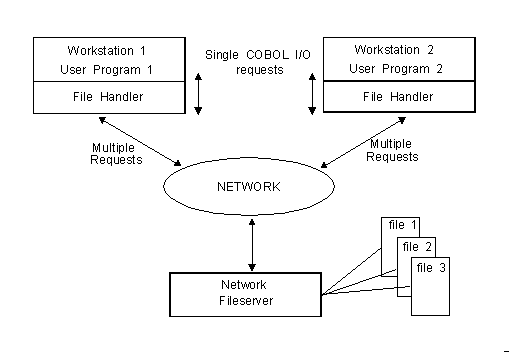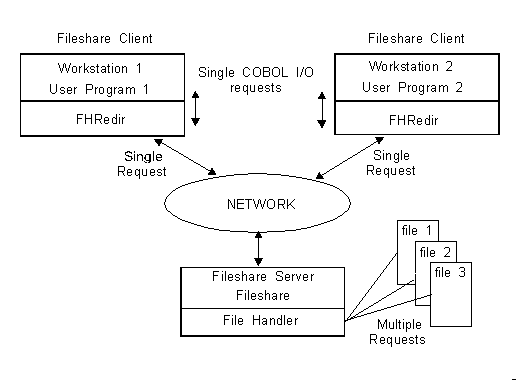|
| Standard Operation |  |
This chapter gives a brief overview of the facilities provided by
Fileshare and also describes how Fileshare works.
Fileshare is best suited to applications that share data files,
concurrently, between many users, across a network. It supports all of the
functionality provided by the base COBOL file handling system and provides
several additional features:
- Reduced network traffic
- Transaction processing
- Rollforward recovery logging
- Logon and file open security checks
The ability of any one application to take advantage of these features
depends on:
- The way the application processes the shared data files
- The type of data files the application shares
- The operating system on which the Fileshare Server is running
- The communications protocol being used between the Fileshare Client
and the Fileshare Server
You do not need to make any program source code changes to use the basic
Fileshare system. Source code changes are only needed to take advantage of
some of the advanced features provided by Fileshare.
Using the base COBOL file handling system, a typical COBOL I/O request
to a shared data file causes the file handler to make several accesses to
that data file across the network. See Figure 1-1.

Figure 1-1: Conventional Network
With Fileshare, a program that needs to access a data file has its
request processed by the File Handling Redirector (FHRedir) module. The
FHRedir module sends the request over the network to a Fileshare Server
that performs the low-level I/O operations and then passes the result of
the I/O operation, including the file status, back to FHRedir. FHRedir
returns the result to the program. See Figure 1-2.

Figure 1-2: Fileshare Network
A Fileshare System is made up of:
| Fileshare Clients
|
A Fileshare Client comprises a user program, making data file I/O
requests, via the FHRedir module. FHRedir redirects the I/O requests to
a Fileshare Server.
|
| Fileshare Servers
|
A Fileshare Server runs on the same machine as the data files that
you want to access. The Fileshare Server accepts requests across the
network from the Fileshare Client, processes them by calling a local
copy of the Micro Focus File Handler and then returns the result to the
Fileshare Client. |
Notes:
- The Fileshare Server and the Fileshare Client can be running on the
same physical machine. For example, with a multi-tasking operating
system such as Windows, the Fileshare Client can run in one session and
the Fileshare Server can run in another session. Using this method, you
can develop Fileshare applications on a single PC without actually
sending data across a network. You should be aware, however, that
performance improvements will not be observed, as no network is being
used.
-
You can also run the Fileshare Server in the same session as the
Fileshare Client using the single user mode of operation. This enables
you to take advantage of advanced Fileshare features,
such as transaction processing, without the
need for a network or multiple sessions. For more information on the
single user mode of operation, see the section
Single
User Mode in the chapter Advanced Operations.
Since a single Fileshare Server processes all the requests from several
Fileshare Clients, it can use a single copy of the Micro Focus File
Handler, regardless of how many users are accessing the Fileshare Server.
This has several advantages:
- The Fileshare Server can open the data files exclusively making full
use of both its own cache and the operating system's cache
- The Fileshare Server does not need to obtain semaphores on the data
file. Normally semaphores are needed to control concurrent access to
shared data files.
- The Fileshare Server can process record locks internally without the
need to make calls to the operating system
Copyright © 1999 MERANT International Limited. All rights reserved.
This document and the proprietary marks and names
used herein are protected by international law.
|
| Standard Operation |  |




